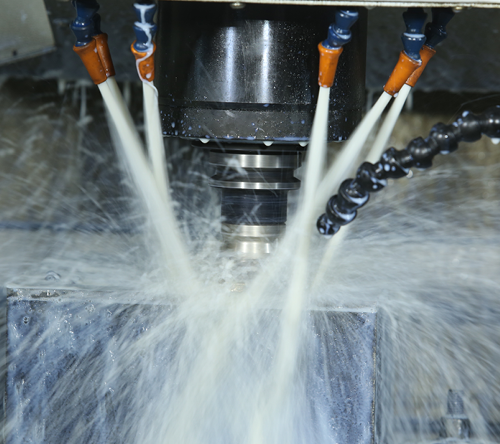Don't have an account?
Creating an account has many benefits: check out faster, keep more than one address, track orders and more.
Or
Checkout as a Guest
Place your order without creating an account for extra convenience.
An Experts Guide to Selecting the Best Soluble Cutting Fluids for your applications
Contents
Indroducing the soluble cutting fluids
Selecting the right soluble cutting fluid is crucial for optimizing machining performance, ensuring tool longevity, and maintaining machine health. Factors such as machine type, water hardness, and specific applications play significant roles in this selection. This guide delves into the various types of cutting fluids, their appropriate dilution ratios, mixing practices, troubleshooting common issues, and reviews of Cutwel's Cutsol and Cleancut ranges.
Understanding Cutting Fluid Types
Mineral Oil-Based (Milky White Emulsions)
Appearance: Milky white when mixed with water.
Composition: High mineral oil content.
Applications: General-purpose machining.
Pros: Excellent lubricity. Low price
Cons: Higher risk of bacterial growth and residue buildup.
These traditional fluids now make up less than 10% of the cutting fluid market with semi-synthetic fluids making up the majority of the market. Milky white fluids though can still be ideal for manual/conventional lathes or milling machines with low cutting speeds.
Semi-Synthetic Fluids
Appearance: Translucent or semi-milky.
Composition: Blend of mineral oil and synthetic additives.
Applications: Versatile; suitable for a range of machining operations.
Pros: Balanced cooling and lubricating properties; reduced residue.
Cons: Moderate cost; may require more monitoring.
Semi-synthetic fluids are the go-to choice for CNC machining. With modern technology, high quality cutting fluids are excellent at repelling bacteria growth, have low foaming qualities and promote longer cutting tool life.
Fully Synthetic Fluids
Appearance: Clear or slightly tinted.
Composition: No mineral oil; entirely synthetic compounds.
Applications: High-speed machining, grinding, and operations requiring superior cooling.
Pros: Excellent cooling; low residue; longer sump life.
Cons: Higher initial cost; may offer less lubricity for heavy-duty operations.
Fully synthetic cutting fluids should be reserved for grinding or very specific high performance machining applications.
Dilution Ratios & Mixing Best Practices
Recommended Dilution Ratios
-
Light Machining: 3–5% concentration.
-
General Machining: 5–7% concentration.
-
Heavy-Duty Machining: 7–10% concentration.
-
Grinding: 3–5% concentration.
Note: Always refer to the manufacturer's guidelines for specific dilution recommendations
Mixing Best Practices
-
Order Matters: Always add concentrate to water, not the reverse, to prevent emulsion instability.
-
Use Mixing Equipment: Employ proportioning mixers or automatic mixing units for consistent results.
-
Monitor Concentration: Regularly check using a refractometer to maintain optimal performance.
Troubleshooting Common Issues
Foaming
-
Causes: Soft water, high-pressure systems, or excessive agitation.
-
Solutions: Use low-foaming formulations; adjust system pressures; consider anti-foam additives.
-
Prevention: use a low foaming soluble cutting fluid in the first place
Premature Tool Wear
-
Causes: Incorrect fluid concentration; unsuitable fluid type.
-
Solutions: Verify and adjust concentration; ensure the fluid matches the application requirements.
-
Prevention: use a high performance cutting fluid suitable for difficult materials
Coolant Drag-Out
-
Causes: Workpieces carrying excessive fluid away from the machine.
-
Solutions: Implement air knives or drip trays; optimize fluid viscosity.
Tramp Oil Contamination
-
Causes: Leaking machine lubricants mixing with cutting fluid.
-
Solutions: Use oil skimmers; regularly clean and maintain machines to prevent leaks.
Unpleasant Odors
-
Causes: Bacterial or fungal growth due to degraded fluid.
-
Solutions: Maintain proper concentration; ensure regular fluid turnover; use biocides if necessary.
Machine Rusting
-
Causes: Low fluid concentration; poor-quality water; fluid degradation.
-
Solutions: Adjust concentration; use deionized water; replace degraded fluid promptly.
Cutwel's Cutsol & Cleancut Cutting Fluid Ranges
-
Type: Semi-synthetic.
-
Features: Low foaming; chlorine-free; suitable for soft water; excellent for high-pressure systems.
-
Applications: Heavy-duty turning, milling, drilling, and deep hole drilling.
-
Type: Semi-synthetic.
-
Features: Heavy-duty performance; low foaming; formaldehyde and chlorine-free; suitable for soft to moderately hard water.
-
Applications: Arduous machining and grinding operations; suitable for materials like titanium, aluminium, and nickel alloys.
-
Type: Semi-synthetic.
-
Features: Formaldehyde and boron-free; high lubricity; suitable for a range of materials including inconel and titanium.
-
Applications: Turning, milling, drilling, and deep hole drilling of exotic alloys.
-
Type: Semi-synthetic.
-
Features: Formaldehyde, boron, and chlorine-free; low foaming; suitable for soft to hard water.
-
Applications: Heavy-duty turning, milling, drilling, and deep hole drilling; compatible with materials like steel, stainless steel, and aluminium.
Conclusion
Selecting the appropriate soluble cutting fluid involves understanding your machining requirements, water hardness, and the specific properties of available fluids. By considering these factors and adhering to best practices in mixing and maintenance, you can enhance machining efficiency, extend tool life, and ensure overall operational excellence.
For expert advice on selecting the right cutting fluid for your application, please contact our technical team on 01924 869 615 or email sales@cutwel.net.

